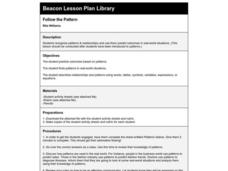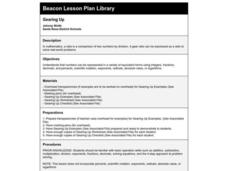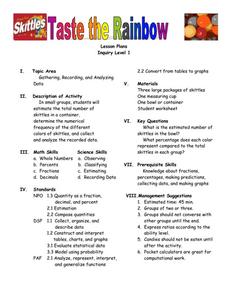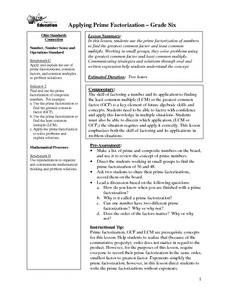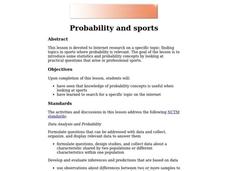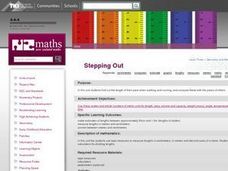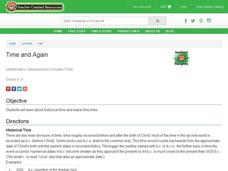Alabama Learning Exchange
Battle to the Death: Adding Integers
Young scholars explore the concept of adding integers. In this adding integers lesson, students simulate the battle of the 300 spartans at Thermopylae. Young scholars use colored game pieces to represent positive and negative numbers. ...
Alabama Learning Exchange
It's Around There Somewhere! Perimeter, and Circumference
Explore the concept of building equations for perimeter and circumference. Learners use rulers to measure the perimeter of half a sheet of paper. Then fold the sheet of paper numerous times, each time measuring perimeter. Learners use...
Curated OER
Dividing Integers
In this dividing integers worksheet, learners complete word problems and regular division problems. Students complete 12 division problems and 4 word problems.
Curated OER
Place Value: numbers with decimals
In this place value worksheet, students insert each digit of numbers with decimals into their correct place value. Students complete 8 problems.
Curated OER
Division Terms, Zero and One
In this division activity, learners complete division problems by filling in the missing numbers, writing the problems, and filling in a chart. Students complete 4 sets of problems.
Curated OER
Problem Solving with Diagrams, Part One
In this diagrams worksheet, students use diagrams to help them solve fraction word problems. Students complete 4 problems on this worksheet.
Curated OER
Finding Patterns in Tiles
Middle schoolers explore perimeter and area of rectangles. In this rectangular lesson, students use tiles to discover the formulas for perimeter and area. Middle schoolers solve for area.
Curated OER
Planning a Trip
Students plan a trip to from 3 to 5 cities of their choice. They design a brochure to travel to the chosen cities. It should be of a quality that it could be used by a customer to decide if they would like to take this trip.
Curated OER
Fractions, Equivalent Fractions and Decimals
Students relate fractions to decimals and find and compare equivalent fractions.
Curated OER
Peer Pressure
Sixth graders estimate, calculate and collaborate with students. They practice refusal skills.
Curated OER
Each Orange Has 8 Slices
Students use pattern blocks to develop an understanding of algebraic generalization(pattern) in order to write a mathematical equation using algebraic symbols.
Curated OER
What are the Chances: A Game of Chance!
Sixth graders experiment with dice, playing cards, pennies and computer-generated simulations to calculate probability. They use compiled data to make predictions.
Curated OER
Follow the Pattern
Pupils survey patterns and relationships and then predict outcomes in real-world situations.
Curated OER
CATCH, TAG and RELEASE
Students apply estimation strategies for problem-solving purposes. They become familiar with one aspect of a marine biologist's work.
Curated OER
Ratios (Cost of a Habit)
Students consider an individual habit and its cost. They study ratios and proportions, and use that knowledge to calculate the cost of a habit over extended periods of time. write a detailed comparison of the costs.
Curated OER
Taste the Rainbow
Students practice estimating and graphing by utilizing Skittles. In this statistics instructional activity, students complete worksheets based on the likelihood of a certain color of skittle coming out of the bag. Students create a...
Curated OER
Applying Prime Factorization
Sixth graders use the prime factorization of numbers to find the greatest common factor and least common multiple. Working in small groups, they solve problems using the greatest common factor and least common multiple.
Curated OER
Pascal's Triangle
Students study Pascal's triangle. They construct their own version of Pascal's triangle, and relate some of the uses for it. While working through this process, students practice their integer multiplication and division skills.
Curated OER
Probability and Sports
Young scholars research topics on the internet where probability is relevant. Students study statistics and probability concepts by looking at practical questions that arise in professional sports.
Curated OER
Stepping Out
Students calculate the length of their pace when walking and running and compare them with the other students' paces. Using tape measurers and calculators, they enter their data in a table, calculate the paces, and calculate the pace of...
Curated OER
Making The Geologic Time Scale Real
Students construct a geologic timeline the size of a football field. They work in small groups to calculate the yardage for significant events in the Earth's history and then as a class pace out all of the events.
Curated OER
Calculating Interest
Students explore the concept that when money is borrowed, people pay to use it because someone else is losing an opportunity to use it while they have it. What you pay to use the money is called interest. The rate of interest is a...
Curated OER
Time and Again
Students examine historical time and make time lines. They study the two main divisions of time; the time before and after the birth of Christ. They also note that time lines are a way of illustrating the length of historical time.
Other popular searches
- Writing Math Expressions
- Evaluating Math Expressions
- Math Expressions 4th Grade
- Simplifying Math Expressions
- Radical Expressions Math
- Expressions Math













